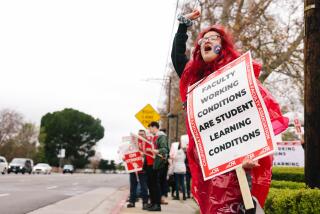Education 1998: Fat Bureaucrats, Weak Teachers
- Share via
Across the entire landscape of higher education in America, a vast shift has been taking place during the past few years that in many ways matches the onslaught on the economic security and working conditions of blue-collar workers since the early 1970s.
Visit any two- or four-year institution of higher education and one finds the same basic pattern: a swelling army of low-paid, overworked junior academics, picking up piecework assignments with near zero economic security; a shrinking sector of senior tenured academics; and a bloating academic bureaucracy over which preside the pashas of the system: the university presidents and senior administrators pulling down enormous salaries and reveling in princely quarters and lavish benefits.
About half the teaching load in higher education is now carried by part-time instructors. Raymond Garcia, who teaches sociology at Michigan State University in East Lansing and reviews these trends in the current issue of CounterPunch, reckons that if we exclude senior-level courses (which are rarely taught by nontenured serfs, as they usually correspond to the research and professional interests of tenured faculty and are frequently the only classes they will teach), the percentage of courses taught by the serfs of the system rises to an amazing 75%.
The excuse often used by administrators in institutions of higher education is that there is a budget squeeze. It’s true there were some lean years in the 1980s but, as Garcia points out, in the 1990s, increases in state appropriations for higher education have held at the rate of inflation across the country, except for California, which has seen higher tuition increases.
Overall, the trends are similar from coast to coast. Tuition is going up and the quality of education is going down. Course offerings shrink, class sizes soar. The biggest single feature of the educational landscape is bureaucratic bloat. Garcia cites a recent University of California study showing the ratio of spending on instruction to spending on administration dropped from $6 to $1 in 1966 to $3 to $1 in 1991. The same study also concludes that during a 25-year period, the number of administrative positions in the UC system increased at nearly twice the rate of teaching positions.
Consider the Kern Community College District, with campuses in Porterville, Bakersfield and Ridgecrest. A Kern County grand jury reviewed the pay boosts that the senior bureaucrats gave themselves and concluded in a scathing public report issued in January, 1995, that the district’s senior administrators were “richly overpaid.” The report said the administrators were trying to hoodwink the taxpayers in a furtive and “self-aggrandizing” scheme in which pay boosts would ultimately range from 12.9% to 49.3%. One position--assistant to the chancellor, instructional services--had been renamed and given a prospective pay hike of more than $27,000. Administration had bloated by 50% while the teaching faculty was cut back and given heavier work loads.
The teachers are now on the verge of a strike as they face the adamant refusal of the district to award them anything more than 2% a year over four years. The teachers want 7% to bring them back into line.
As the third millennium approaches, it is not hard to discern the shape of things to come. Most of what passes for education will be imparted through online cybercourses. Lavishly paid administrators will supervise these “virtual” universities, reliant on lumpen instructors to do the grunt work. A few tenured professors will remain available to whore for corporate funding, which will pay for the supercomputers.
As every generation of student radicals has discovered, high-minded talk about the disinterested pursuit of learning soon melts away under the Klieg lights of reality. The function of higher education in capitalist society is now finding its corresponding form without a tincture of shame. What the denizens of Grub Street in academia need to find, like any reserve army of the semi-employed, are the proper organizations for self-defense and resistance.
More to Read
Sign up for Essential California
The most important California stories and recommendations in your inbox every morning.
You may occasionally receive promotional content from the Los Angeles Times.













